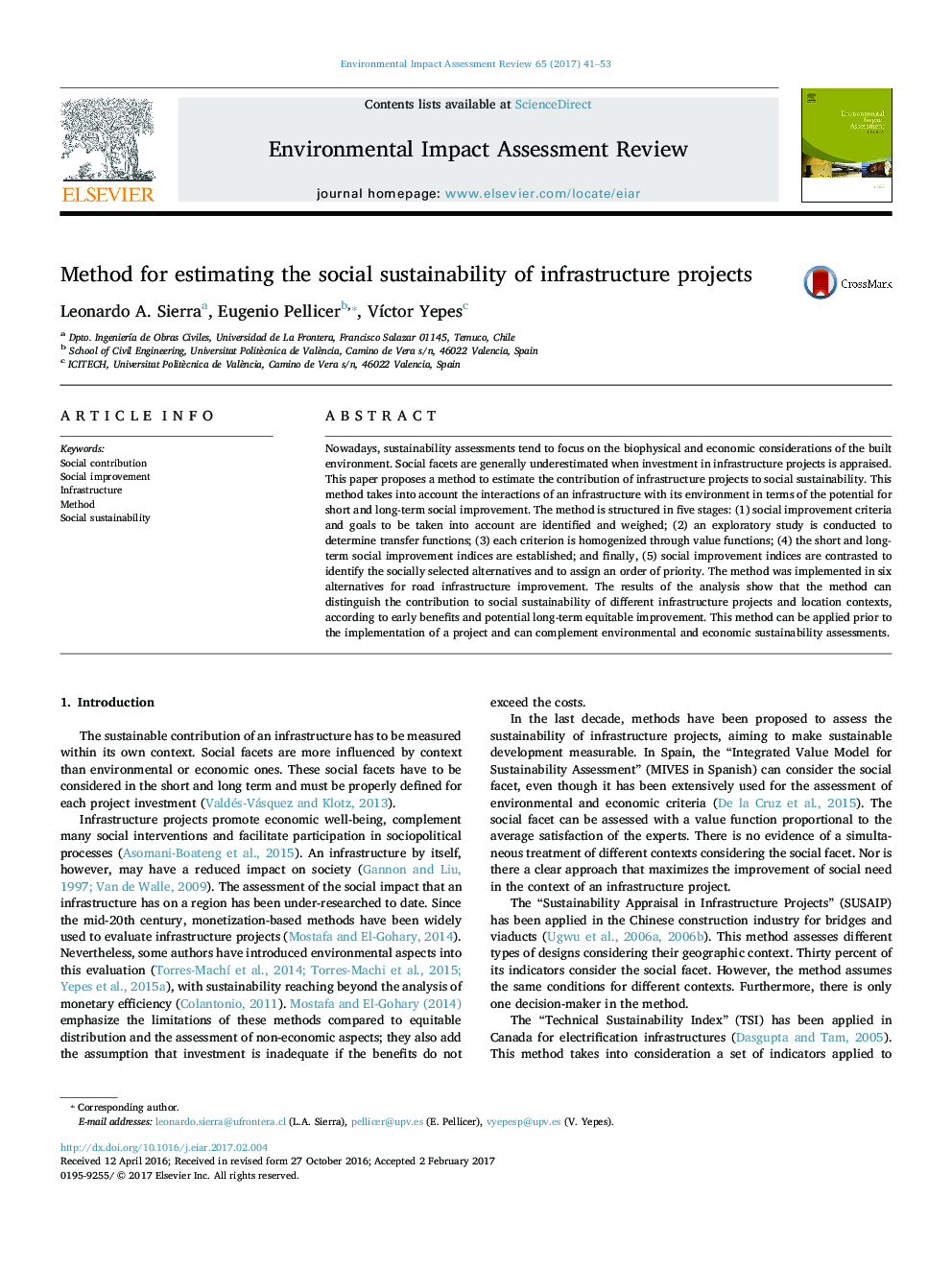| کد مقاله | کد نشریه | سال انتشار | مقاله انگلیسی | نسخه تمام متن |
|---|---|---|---|---|
| 5115585 | 1484980 | 2017 | 13 صفحه PDF | دانلود رایگان |
عنوان انگلیسی مقاله ISI
Method for estimating the social sustainability of infrastructure projects
ترجمه فارسی عنوان
روش برای برآورد پایداری اجتماعی پروژه های زیربنایی
دانلود مقاله + سفارش ترجمه
دانلود مقاله ISI انگلیسی
رایگان برای ایرانیان
کلمات کلیدی
مشارکت اجتماعی، بهبود اجتماعی، زیر ساخت، روش، پایداری اجتماعی،
ترجمه چکیده
امروزه ارزیابی های پایداری بر ملاحظات بیوفیزیکی و اقتصادی محیط زیست تمرکز دارند. هنگامی که سرمایه گذاری در پروژه های زیربنایی مورد ارزیابی قرار می گیرد، جنبه های اجتماعی به طور کلی کم اهمیت است. این مقاله یک روش برای ارزیابی سهم پروژه های زیربنایی در پایداری اجتماعی را پیشنهاد می کند. این روش، تعاملات زیربنایی با محیط خود را از لحاظ امکان بهبود کوتاه مدت و بلندمدت اجتماعی در نظر می گیرد. این روش در پنج مرحله تشکیل شده است: (1) معیارهای بهبود اجتماعی و اهدافی که باید مورد توجه قرار گیرند شناسایی و وزن می شوند؛ (2) یک مطالعه اکتشافی برای تعیین توابع انتقال انجام شده است؛ (3) هر معیار از طریق توابع ارزش همگن می شود؛ (4) شاخص های بهبود اجتماعی کوتاه مدت و دراز مدت ایجاد می شود؛ و در نهایت، (5) شاخص های بهبود اجتماعی به منظور شناسایی جایگزین های انتخاب شده اجتماعی و تعیین اولویت در نظر گرفته می شوند. این روش در شش جایگزین برای بهبود زیرساخت های جاده ای اجرا شد. نتایج تجزیه و تحلیل نشان می دهد که این روش می تواند سهم به پایداری اجتماعی پروژه های زیربنایی مختلف و شرایط محیطی را با توجه به مزایای اولیه و امکان بالقوه درازمدت عادلانه تشخیص دهد. این روش می تواند قبل از اجرای یک پروژه اجرا شود و می تواند ارزیابی های پایداری زیست محیطی و اقتصادی را بهبود بخشد.
موضوعات مرتبط
مهندسی و علوم پایه
مهندسی انرژی
انرژی های تجدید پذیر، توسعه پایدار و محیط زیست
چکیده انگلیسی
Nowadays, sustainability assessments tend to focus on the biophysical and economic considerations of the built environment. Social facets are generally underestimated when investment in infrastructure projects is appraised. This paper proposes a method to estimate the contribution of infrastructure projects to social sustainability. This method takes into account the interactions of an infrastructure with its environment in terms of the potential for short and long-term social improvement. The method is structured in five stages: (1) social improvement criteria and goals to be taken into account are identified and weighed; (2) an exploratory study is conducted to determine transfer functions; (3) each criterion is homogenized through value functions; (4) the short and long-term social improvement indices are established; and finally, (5) social improvement indices are contrasted to identify the socially selected alternatives and to assign an order of priority. The method was implemented in six alternatives for road infrastructure improvement. The results of the analysis show that the method can distinguish the contribution to social sustainability of different infrastructure projects and location contexts, according to early benefits and potential long-term equitable improvement. This method can be applied prior to the implementation of a project and can complement environmental and economic sustainability assessments.
ناشر
Database: Elsevier - ScienceDirect (ساینس دایرکت)
Journal: Environmental Impact Assessment Review - Volume 65, July 2017, Pages 41-53
Journal: Environmental Impact Assessment Review - Volume 65, July 2017, Pages 41-53
نویسندگان
Leonardo A. Sierra, Eugenio Pellicer, VÃctor Yepes,
